Evaluating the Sustainability Dimensions in the Food Supply Chain: Literature Review and Research Routes
Abstract
1. Introduction
1.1. Sustainability Challenges in the FSC
1.2. Research Gap and Purpose Statement
2. Methodology
2.1. Choosing a Review Methodology
2.2. Questions Formulation
“What are the main research routes addressed by the studies on sustainable food supply chain?”.
“What are the main food supply chain models studied in association with sustainability?”
“Is one of the sustainability dimensions more investigated than the other ones?”
2.3. Definition of the Protocol for Review
2.4. Analysis of the Results and Data Synthesis
3. Results: Performance Analysis
3.1. Publication Trend
3.2. Top Ten Journals
3.3. Subject Areas
3.4. Geographic Distribution
4. Results: Science Mapping Analysis
4.1. Cluster Analysis
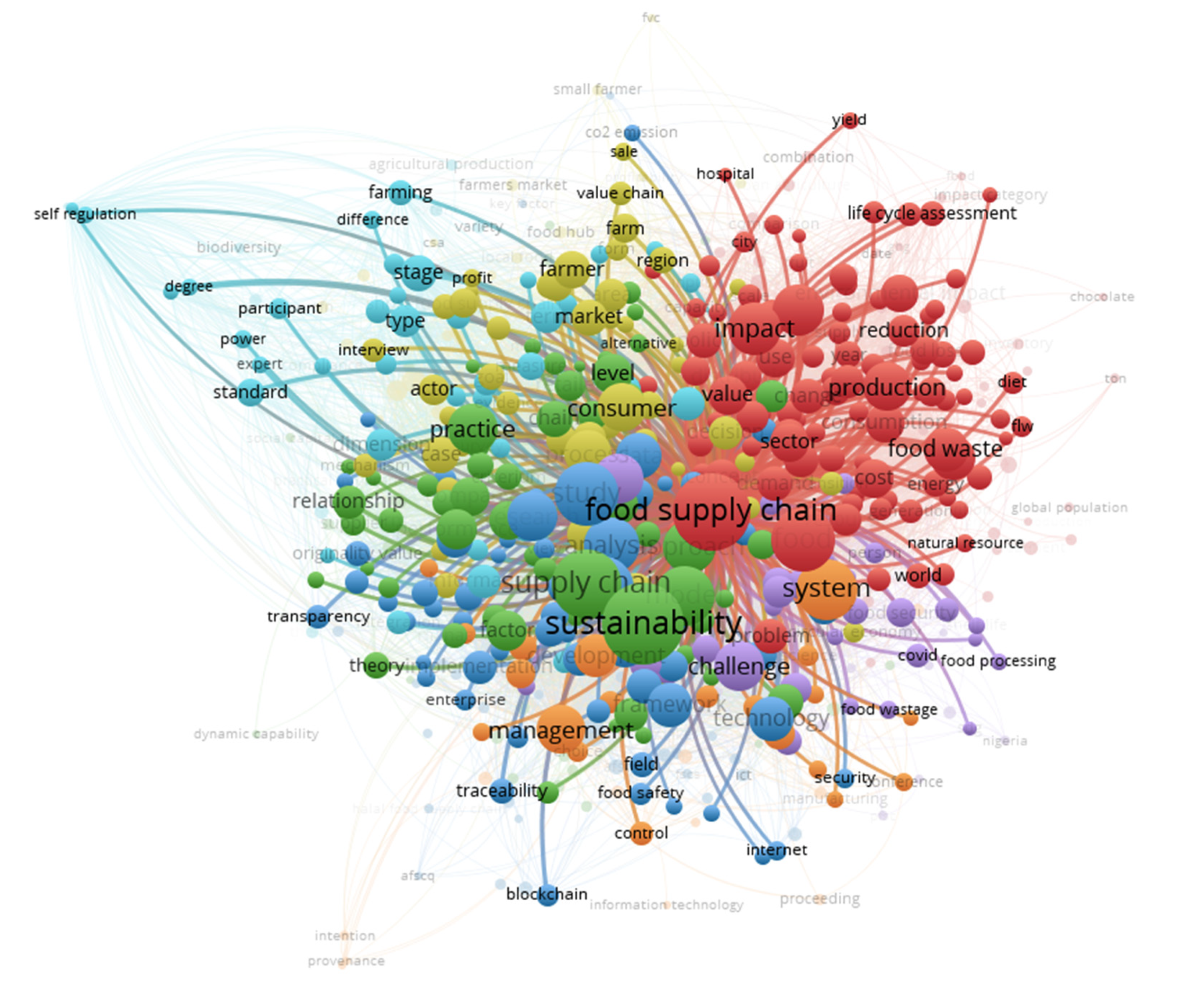
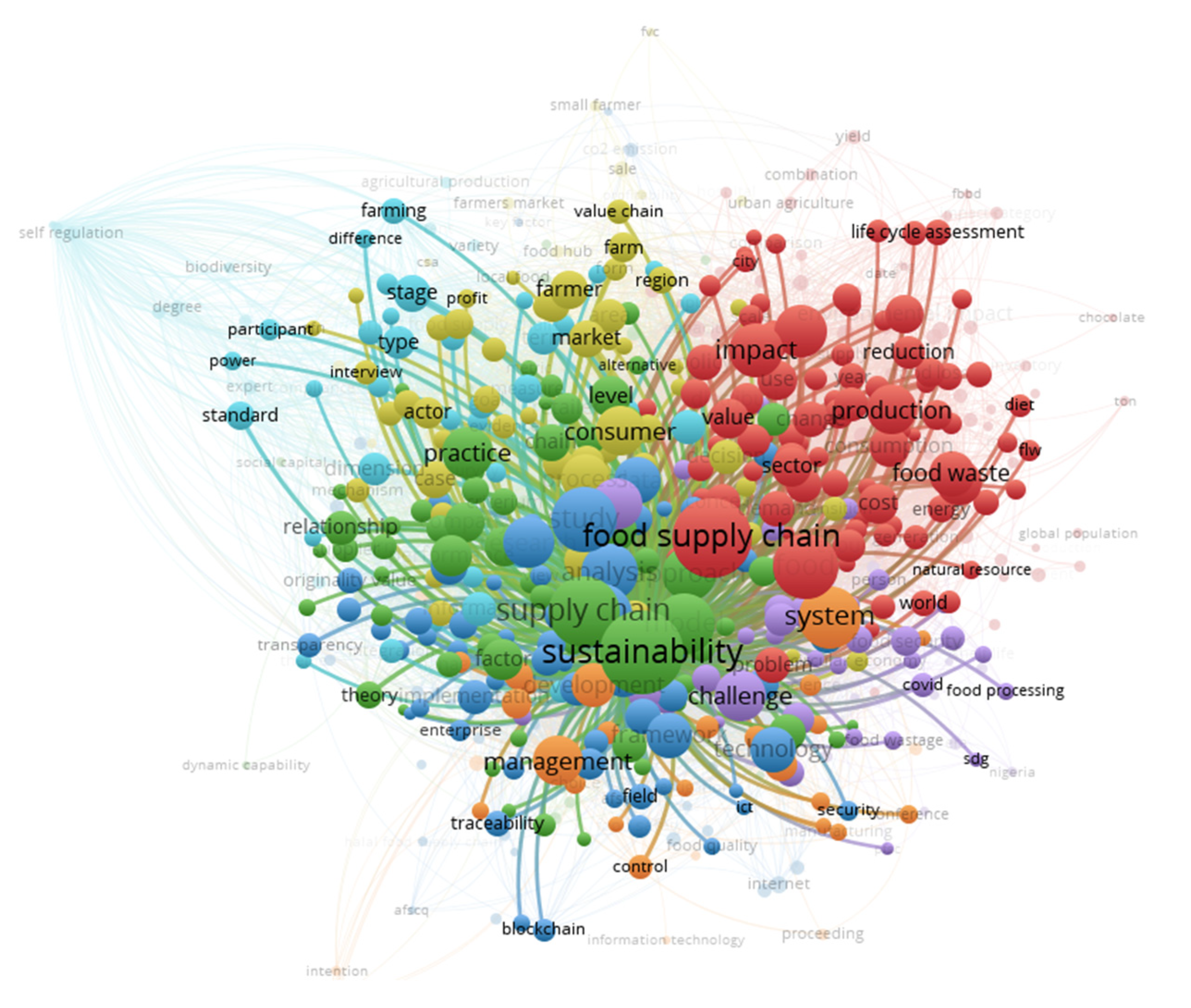
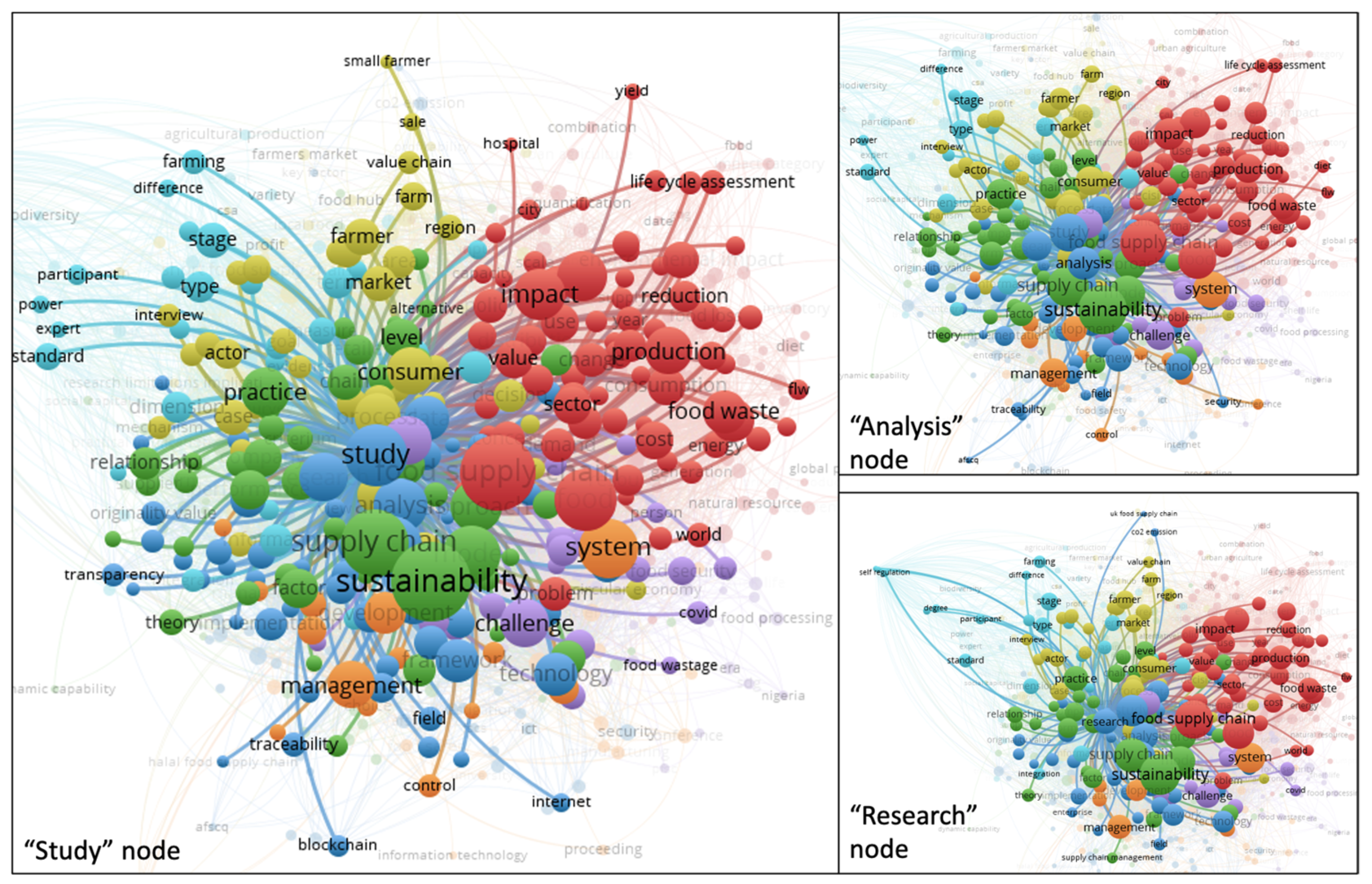

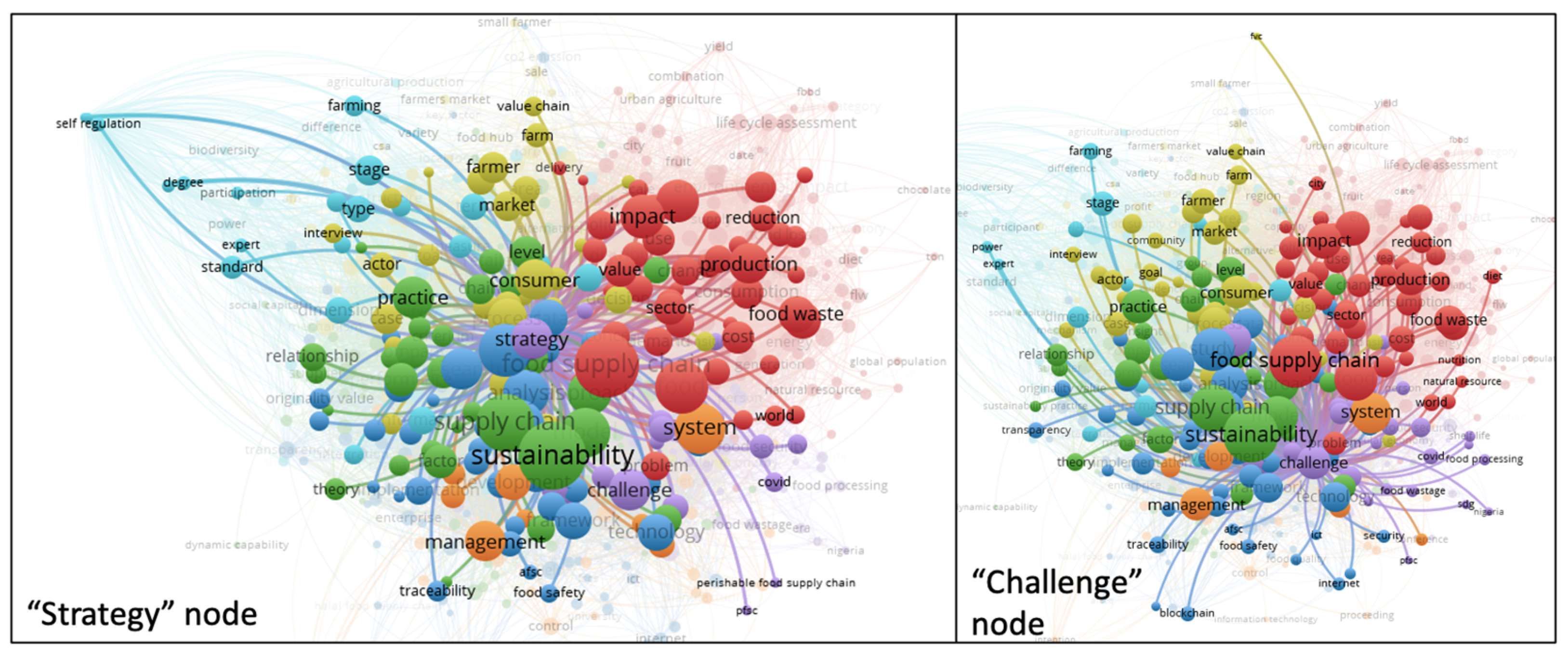
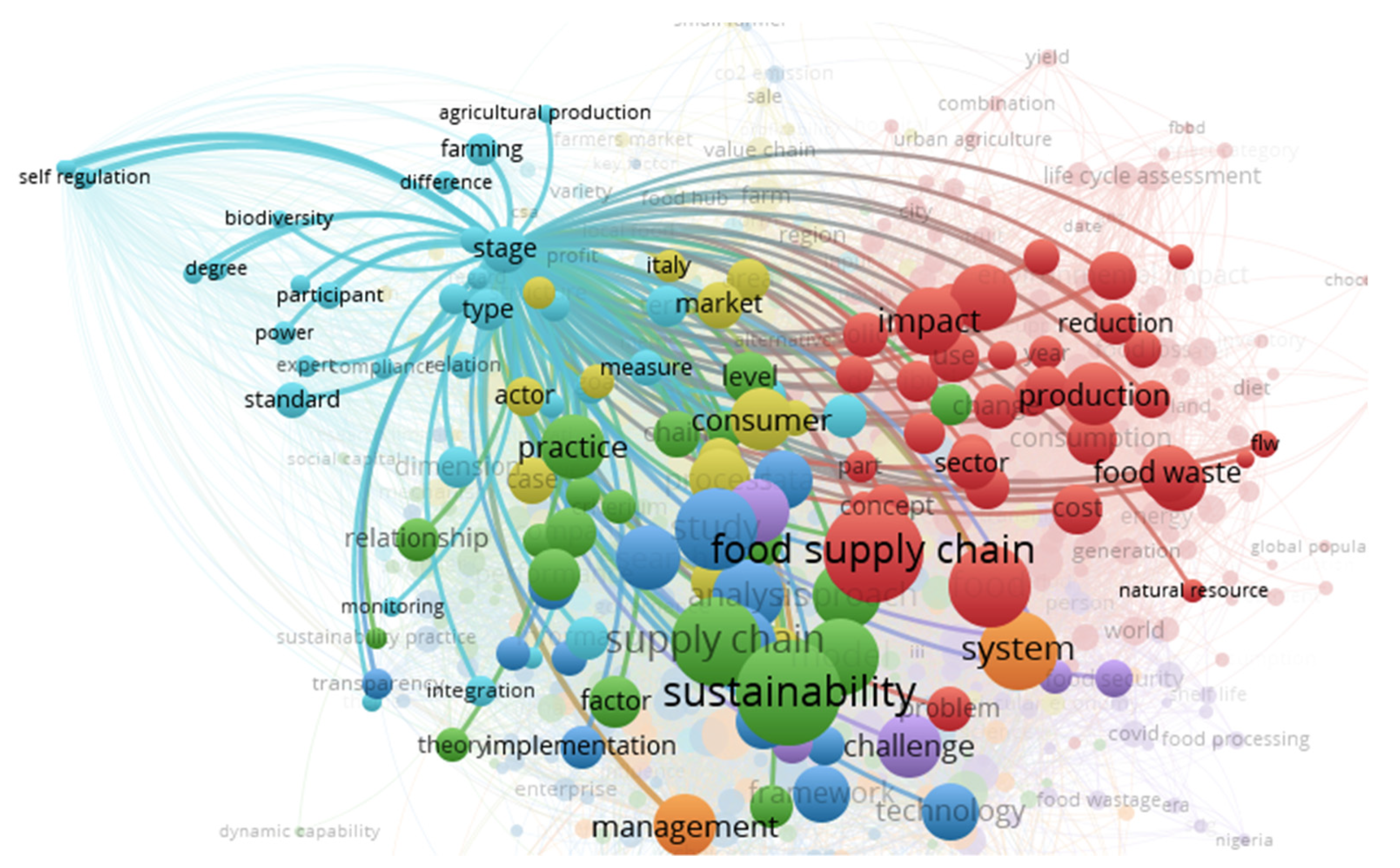

4.2. Density Visualization
4.3. Overlay Visualization
5. Discussions
6. Conclusions, Implications and Limitations
6.1. Implications
6.2. Limitations
Author Contributions
Funding
Institutional Review Board Statement
Informed Consent Statement
Data Availability Statement
Acknowledgments
Conflicts of Interest
References
- Donald, B.; Gertler, M.; Gray, M.; Lobao, L. Re-Regionalizing the Food System? Camb. J. Reg. Econ. Soc. 2010, 3, 171–175. [Google Scholar] [CrossRef]
- Colonna, P.; Fournier, S.; Touzard, J.-M.; Abécassis, J.; Broutin, C.; Chabrol, D.; Champenois, A.; Deverre, C.; François, M.; Stimolo, D.L. Food Systems; Cambridge University Press: Cambridge, UK, 2013. [Google Scholar]
- Ceravolo, P.; Azzini, A.; Damiani, E.; Lazoi, M.; Marra, M.; Corallo, A. Translating Process Mining Results into Intelligible Business Information. In Proceedings of the 11th International Knowledge Management in Organizations Conference on The changing face of Knowledge Management Impacting Society, Hagen, Germany, 25 July 2016; ACM: Hagen Germany, 2016; pp. 1–8. [Google Scholar]
- Yakovleva, N. Measuring the Sustainability of the Food Supply Chain: A Case Study of the UK. J. Environ. Policy Plan. 2007, 9, 75–100. [Google Scholar] [CrossRef]
- Green, K.; Foster, C. Give Peas a Chance: Transformations in Food Consumption and Production Systems. Technol. Forecast. Soc. Chang. 2005, 72, 663–679. [Google Scholar] [CrossRef]
- Heller, M.C.; Keoleian, G.A. Assessing the Sustainability of the US Food System: A Life Cycle Perspective. Agric. Syst. 2003, 76, 1007–1041. [Google Scholar] [CrossRef]
- Hardy, C.; Graedel, T.E. Industrial Ecosystems as Food Webs. J. Ind. Ecol. 2002, 6, 29–38. [Google Scholar] [CrossRef]
- Wirsenius, S. The Biomass Metabolism of the Food System: A Model-Based Survey of the Global and Regional Turnover of Food Biomass. J. Ind. Ecol. 2003, 7, 47–80. [Google Scholar] [CrossRef]
- Barrett, H.R.; Ilbery, B.W.; Brown, A.W.; Binns, T. Globalization and the Changing Networks of Food Supply: The Importation of Fresh Horticultural Produce from Kenya into the UK. Trans. Inst. Br. Geogr. 1999, 24, 159–174. [Google Scholar] [CrossRef]
- Marsden, T.; Banks, J.; Bristow, G. Food Supply Chain Approaches: Exploring Their Role in Rural Development. Sociol. Rural. 2000, 40, 424–438. [Google Scholar] [CrossRef]
- Stevens, G.C. Integrating the Supply Chain. Int. J. Phys. Distrib. Mater. Manag. 1989, 19, 3–8. [Google Scholar] [CrossRef]
- Parsons, K.; Hakes, C.; Wells, R. What Is the Food System? A Food Policy Perspective. Centre for Food Policy. 2019. Available online: https://openaccess.city.ac.uk/id/eprint/22795 (accessed on 25 October 2021).
- FAO. High Level Panel of Experts (HLPE). In Nutrition and Food Systems; FAO: Roma, Italy, 2017. [Google Scholar]
- Gómez, M.I.; Ricketts, K.D. Food Value Chain Transformations in Developing Countries: Selected Hypotheses on Nutritional Implications. Food Policy 2013, 42, 139–150. [Google Scholar] [CrossRef]
- Manzini, R.; Accorsi, R. The New Conceptual Framework for Food Supply Chain Assessment. J. Food Eng. 2013, 115, 251–263. [Google Scholar] [CrossRef]
- Manning, L.; Soon, J.M. Building Strategic Resilience in the Food Supply Chain. Br. Food J. 2016, 118, 1477–1493. [Google Scholar] [CrossRef]
- Wu, S.-H.; Ho, C.-T.; Nah, S.-L.; Chau, C.-F. Global Hunger: A Challenge to Agricultural, Food, and Nutritional Sciences. Crit. Rev. Food Sci. Nutr. 2014, 54, 151–162. [Google Scholar] [CrossRef]
- Bartlett, A.A. Reflections on Sustainability, Population Growth, and the Environment. Popul. Environ. 1994, 16, 5–35. [Google Scholar] [CrossRef]
- Porter, S.D.; Reay, D.S. Addressing Food Supply Chain and Consumption Inefficiencies: Potential for Climate Change Mitigation. Reg. Environ. Chang. 2016, 16, 2279–2290. [Google Scholar] [CrossRef]
- Jacobsen, J.B.; Hanley, N. Are There Income Effects on Global Willingness to Pay for Biodiversity Conservation? Environ. Resour. Econ. 2009, 43, 137–160. [Google Scholar] [CrossRef]
- Scheil-Adlung, X. Global Evidence on Inequities in Rural Health Protection: New Data on Rural Deficits in Health Coverage for 174 Countries; International Labour Organization: Geneva, Switzerland, 2015. [Google Scholar]
- Ventura, D.D.F.L.; Giulio, G.M.D.; Rached, D.H. Lessons from the Covid-19 Pandemic: Sustainability Is an Indispensable Condition of Global Health Security. Ambient. Soc. 2020, 23, e0108. [Google Scholar] [CrossRef]
- Vanotti, M.; Szogi, A.; Pilar Bernal, M.; Martinez, J. Livestock Waste Treatment Systems of the Future: A Challenge to Environmental Quality, Food Safety, and Sustainability. OECD Workshop. Bioresour. Technol. 2009, 100, 5371–5373. [Google Scholar] [CrossRef][Green Version]
- Fischer, E. If Not Now, When? The Timeliness of Developing a Dialogue between Consumer Culture Theoretic and Macromarketing Perspectives. J. Macromarketing 2019, 39, 103–105. [Google Scholar] [CrossRef]
- Reynolds, C.; Goucher, L.; Quested, T.; Bromley, S.; Gillick, S.; Wells, V.K.; Evans, D.; Koh, L.; Carlsson Kanyama, A.; Katzeff, C.; et al. Review: Consumption-Stage Food Waste Reduction Interventions—What Works and How to Design Better Interventions. Food Policy 2019, 83, 7–27. [Google Scholar] [CrossRef]
- Banasik, A.; Kanellopoulos, A.; Claassen, G.D.H.; Bloemhof-Ruwaard, J.M.; van der Vorst, J.G.A.J. Assessing Alternative Production Options for Eco-Efficient Food Supply Chains Using Multi-Objective Optimization. Ann Oper Res 2017, 250, 341–362. [Google Scholar] [CrossRef]
- Lechenet, M.; Bretagnolle, V.; Bockstaller, C.; Boissinot, F.; Petit, M.-S.; Petit, S.; Munier-Jolain, N.M. Reconciling Pesticide Reduction with Economic and Environmental Sustainability in Arable Farming. PLoS ONE 2014, 9, e97922. [Google Scholar] [CrossRef]
- McNeely, J.A.; Scherr, S.J. Ecoagriculture: Strategies to Feed the World and Save Biodiversity; Island Press: Washington, DC, USA, 2003; ISBN 978-1-55963-645-2. [Google Scholar]
- Elkington, J. Partnerships Fromcannibals with Forks: The Triple Bottom Line of 21st-Century Business. Environ. Qual. Manag. 1998, 8, 37–51. [Google Scholar] [CrossRef]
- Kristensen, H.S.; Mosgaard, M.A. A Review of Micro Level Indicators for a Circular Economy—Moving Away from the Three Dimensions of Sustainability? J. Clean. Prod. 2020, 243, 118531. [Google Scholar] [CrossRef]
- European Parliament May 2020. Available online: https://www.europarl.europa.eu/doceo/document/TA-9-2020-05-15_EN.html (accessed on 25 October 2021).
- EPA May 2020. Available online: https://www.epa.gov/risk/regional-screening-levels-rsls (accessed on 25 October 2021).
- Canfora, I. Is the Short Food Supply Chain an Efficient Solution for Sustainability in Food Market? Agric. Agric. Sci. Procedia 2016, 8, 402–407. [Google Scholar] [CrossRef]
- Cagliano, R.; Caniato, F.F.; Worley, C.G. Acknowledgements’, Organizing Supply Chain Processes for Sustainable Innovation in the Agri-Food Industry; Organizing for Sustainable Effectiveness; Emerald Group Publishing Limited: Bentley, UK, 2016; Volume 5, pp. xvii–xviii. [Google Scholar]
- Sgarbossa, F.; Russo, I. A Proactive Model in Sustainable Food Supply Chain: Insight from a Case Study. Int. J. Prod. Econ. 2017, 183, 596–606. [Google Scholar] [CrossRef]
- Saurabh, S.; Dey, K. Blockchain Technology Adoption, Architecture, and Sustainable Agri-Food Supply Chains. J. Clean. Prod. 2021, 284, 124731. [Google Scholar] [CrossRef]
- Gruchmann, T.; Böhm, M.; Krumme, K.; Funcke, S.; Hauser, S.; Melkonyan, A. Local and Sustainable Food Businesses: Assessing the Role of Supply Chain Coordination. In Innovative Logistics Services and Sustainable Lifestyles; Melkonyan, A., Krumme, K., Eds.; Springer International Publishing: Cham, Switzerland, 2019; pp. 143–163. ISBN 978-3-319-98466-7. [Google Scholar]
- Knickel, K.; Jahn, G.; Roep, D.; Wiskerke, J.S.C. Enhancing Sustainable Food Supply Chain Initiatives. Nourishing Networks: Fourteen Lessons about Creating Sustainable Food Supply Chains; Reed Business Information: Doetinchem, The Netherlands, 2006; pp. 165–176. [Google Scholar]
- Deutz, P.; Ioppolo, G. From Theory to Practice: Enhancing the Potential Policy Impact of Industrial Ecology. Sustainability 2015, 7, 2259–2273. [Google Scholar] [CrossRef]
- Derqui, B.; Fayos, T.; Fernandez, V. Towards a More Sustainable Food Supply Chain: Opening up Invisible Waste in Food Service. Sustainability 2016, 8, 693. [Google Scholar] [CrossRef]
- Binyon, S. Reducing and Managing Waste in the Food Industry: Food Industry Sustainability Best Practice Workshop; Food and Drink Federation: London, UK, 2007. [Google Scholar]
- Christopher, M.; Holweg, M. “Supply Chain 2.0”: Managing Supply Chains in the Era of Turbulence. Int. J. Phys. Distrib. Logist. Manag. 2011, 41, 63–82. [Google Scholar] [CrossRef]
- Lawo, D.; Neifer, T.; Esau, M.; Vonholdt, S.; Stevens, G. From Farms to Fridges: A Consumer-Oriented Design Approach to Sustainable Food Traceability. Sustain. Prod. Consum. 2021, 27, 282–297. [Google Scholar] [CrossRef]
- Chiffoleau, Y.; Dourian, T. Sustainable Food Supply Chains: Is Shortening the Answer? A Literature Review for a Research and Innovation Agenda. Sustainability 2020, 12, 9831. [Google Scholar] [CrossRef]
- Bloemhof, J.M.; Soysal, M. Sustainable Food Supply Chain Design. In Sustainable Supply Chains; Bouchery, Y., Corbett, C.J., Fransoo, J.C., Tan, T., Eds.; Springer Series in Supply Chain Management; Springer International Publishing: Cham, Switzerland, 2017; Volume 4, pp. 395–412. ISBN 978-3-319-29789-7. [Google Scholar]
- Anderson, M.D. Roles of Rural Areas in Sustainable Food System Transformations. Development 2015, 58, 256–262. [Google Scholar] [CrossRef]
- Paloviita, A. Food Security Is None Of Your Business? Food Supply Chain Management In Support of a Sustainable Food System. OSCM Int. J. 2017, 10, 100–108. [Google Scholar] [CrossRef]
- Bale, J.S.; van Lenteren, J.C.; Bigler, F. Biological Control and Sustainable Food Production. Phil. Trans. R. Soc. B 2008, 363, 761–776. [Google Scholar] [CrossRef]
- Zhu, Z.; Chu, F.; Dolgui, A.; Chu, C.; Zhou, W.; Piramuthu, S. Recent Advances and Opportunities in Sustainable Food Supply Chain: A Model-Oriented Review. Int. J. Prod. Res. 2018, 56, 5700–5722. [Google Scholar] [CrossRef]
- Beske, P.; Land, A.; Seuring, S. Sustainable Supply Chain Management Practices and Dynamic Capabilities in the Food Industry: A Critical Analysis of the Literature. Int. J. Prod. Econ. 2014, 152, 131–143. [Google Scholar] [CrossRef]
- Soysal, M.; Bloemhof-Ruwaard, J.M.; Meuwissen, M.P.M.; Van Der Vorst, J.G.A.J. A Review on Quantitative Models for Sustainable Food Logistics Management. Int. J. Food Syst. Dyn. 2012, 3, 136–155. [Google Scholar] [CrossRef]
- Stephens, S. Supply Chain Operations Reference Model Version 5.0: A New Tool to Improve Supply Chain Efficiency and Achieve Best Practice. Inf. Syst. Front. 2001, 3, 471–476. [Google Scholar] [CrossRef]
- Tranfield, D.; Denyer, D.; Smart, P. Towards a Methodology for Developing Evidence-Informed Management Knowledge by Means of Systematic Review. Br. J. Manag. 2003, 14, 207–222. [Google Scholar] [CrossRef]
- Liberati, G.; Federici, S.; Pasqualotto, E. Extracting Neurophysiological Signals Reflecting Users’ Emotional and Affective Responses to BCI Use: A Systematic Literature Review. NRE 2015, 37, 341–358. [Google Scholar] [CrossRef] [PubMed]
- Creswell, J.W.; Creswell, J.D. Research Design: Qualitative, Quantitative, and Mixed Methods Approaches; Sage Publications: Southend Oaks, CA, USA, 2017; ISBN 1-5063-8671-7. [Google Scholar]
- Crossan, M.M.; Apaydin, M. A Multi-dimensional Framework of Organizational Innovation: A Systematic Review of the Literature. J. Manag. Stud. 2010, 47, 1154–1191. [Google Scholar] [CrossRef]
- Snyder, H. Literature Review as a Research Methodology: An Overview and Guidelines. J. Bus. Res. 2019, 104, 333–339. [Google Scholar] [CrossRef]
- Paul, J.; Criado, A.R. The Art of Writing Literature Review: What Do We Know and What Do We Need to Know? Int. Bus. Rev. 2020, 29, 101717. [Google Scholar] [CrossRef]
- Paul, J.; Parthasarathy, S.; Gupta, P. Exporting Challenges of SMEs: A Review and Future Research Agenda. J. World Bus. 2017, 52, 327–342. [Google Scholar] [CrossRef]
- Cronin, P.; Ryan, F.; Coughlan, M. Undertaking a Literature Review: A Step-by-Step Approach. Br. J. Nurs. 2008, 17, 38–43. [Google Scholar] [CrossRef]
- Ely, C.; Scott, I. Essential Study Skills for Nursing; Elsevier Health Sciences: Amsterdam, The Netherlands, 2007; ISBN 0-7234-3371-2. [Google Scholar]
- Mishra, D.; Gunasekaran, A.; Childe, S.J.; Papadopoulos, T.; Dubey, R.; Wamba, S. Vision, Applications and Future Challenges of Internet of Things: A Bibliometric Study of the Recent Literature. Ind. Manag. Data Syst. 2016, 116, 1331–1355. [Google Scholar] [CrossRef]
- Yong-Hak, J. The Definitive Resource for Global Research Web of Science Access Powerful Cited Reference Searching and Multidisciplinary Content; Thomson Reuters: Toronto, ON, Canada, 2019. [Google Scholar]
- Yas, H.; Jusoh, A.; Abbas, A.F.; Mardani, A.; Nor, K.M. A Review and Bibliometric Analysis of Service Quality and Customer Satisfaction by Using Scopus Database. Int. J. Manag. 2020, 11, 459–470. [Google Scholar]
- Oliveira, A.S.; de Barros, M.D.; de Carvalho Pereira, F.; Gomes, C.F.S.; da Costa, H.G. Prospective Scenarios: A Literature Review on the Scopus Database. Futures 2018, 100, 20–33. [Google Scholar] [CrossRef]
- Zupic, I.; Čater, T. Bibliometric Methods in Management and Organization. Organ. Res. Methods 2015, 18, 429–472. [Google Scholar] [CrossRef]
- Zhu, C.; Tong, P.; Song, Z. A Bibliometric and Visual Analysis of Environmental Behavior Research. Sustainability 2021, 13, 10338. [Google Scholar] [CrossRef]
- Ellegaard, O.; Wallin, J.A. The Bibliometric Analysis of Scholarly Production: How Great Is the Impact? Scientometrics 2015, 105, 1809–1831. [Google Scholar] [CrossRef]
- Lin, W.-Y.C. Research Status and Characteristics of Library and Information Science in Taiwan: A Bibliometric Analysis. Scientometrics 2012, 92, 7–21. [Google Scholar] [CrossRef]
- Huffman, M.D.; Baldridge, A.; Bloomfield, G.S.; Colantonio, L.D.; Prabhakaran, P.; Ajay, V.S.; Suh, S.; Lewison, G.; Prabhakaran, D. Global Cardiovascular Research Output, Citations, and Collaborations: A Time-Trend, Bibliometric Analysis (1999–2008). PLoS ONE 2013, 8, e83440. [Google Scholar] [CrossRef]
- Dalpé, R. Bibliometric Analysis of Biotechnology. Scientometrics 2002, 55, 189–213. [Google Scholar] [CrossRef]
- White, H.D.; McCain, K.W. Visualizing a Discipline: An Author Co-citation Analysis of Information Science, 1972–1995. J. Am. Soc. Inf. Sci. 1998, 49, 327–355. [Google Scholar]
- Wallin, J.A. Bibliometric Methods: Pitfalls and Possibilities. Basic Clin Pharm. Toxicol 2005, 97, 261–275. [Google Scholar] [CrossRef] [PubMed]
- van Eck, N.J.; Waltman, L. Software Survey: VOSviewer, a Computer Program for Bibliometric Mapping. Scientometrics 2010, 84, 523–538. [Google Scholar] [CrossRef]
- Ghauri, P.N.; Grønhaug, K. Research Methods in Business Studies: A Practical Guide; Pearson Education: London, UK, 2005; ISBN 0-273-68156-7. [Google Scholar]
- He, Q. Knowledge Discovery through Co-Word Analysis. Libr. Trends. 1999, 48, 133–159. [Google Scholar]
- Chabowski, B.R.; Samiee, S.; Hult, G.T.M. A Bibliometric Analysis of the Global Branding Literature and a Research Agenda. J. Int. Bus. Stud. 2013, 44, 622–634. [Google Scholar] [CrossRef]
- Naccarato, P.; Nowak, Z.; Eckert, E.K. Representing Italy through Food; Bloomsbury Publishing: London, UK, 2017; ISBN 978-1-4742-8043-3. [Google Scholar]
- Simone Filippeti March 2021. Available online: https://www.ilsole24ore.com/art/la-brexit-fa-crollare-l-export-cibo-italiano-regno-unito-38percento-gennaio-ADx5x8MB?refresh_ce=1 (accessed on 25 October 2021).
- Marcello Antonioni April 2020. Available online: https://www.exportplanning.com/magazine-italia/article/2020/04/20/alimentantare-confezionato-e-bevande-significativa-crescita-del-made-in-italy-negli-usa/ (accessed on 25 October 2021).
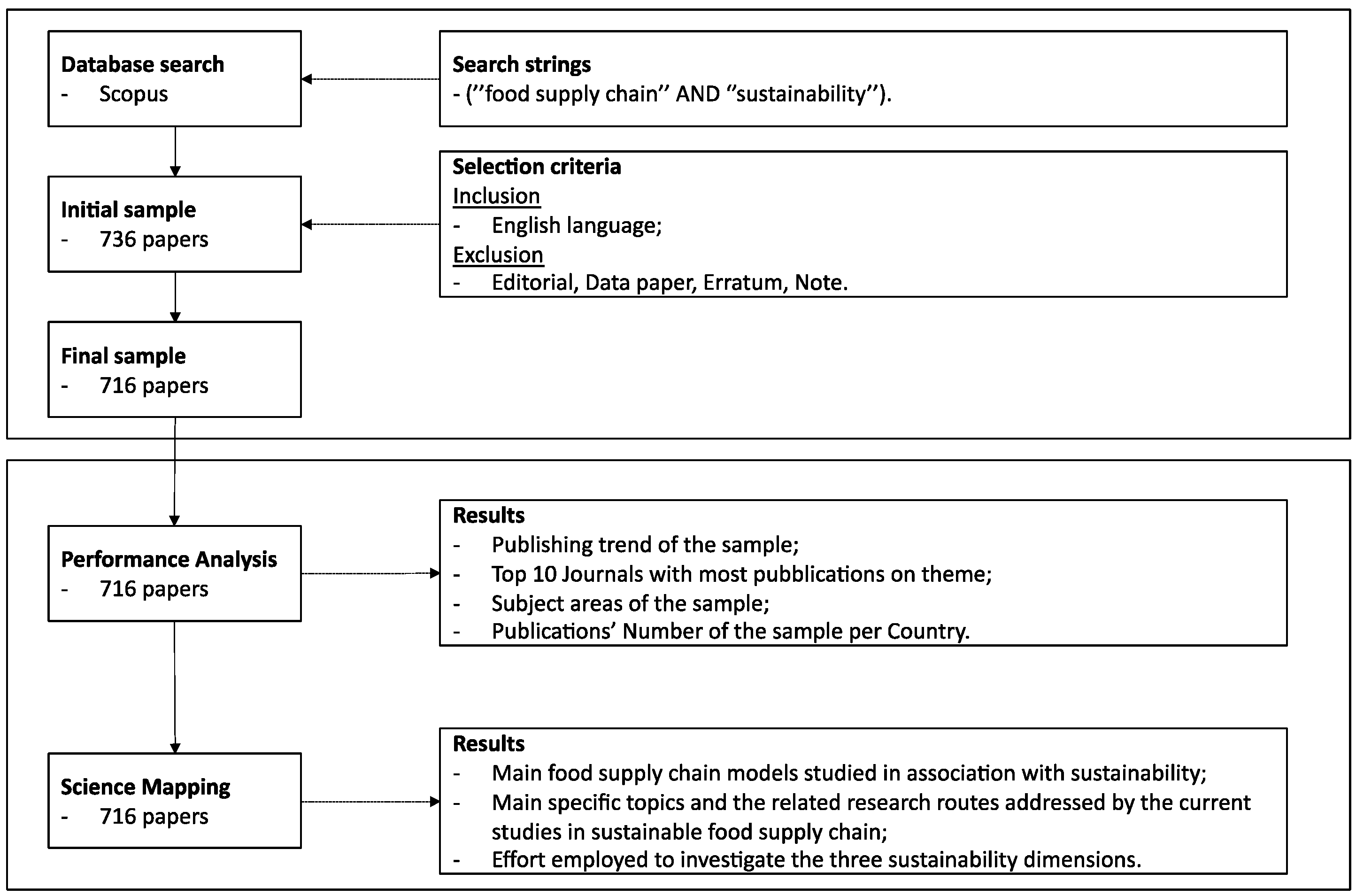

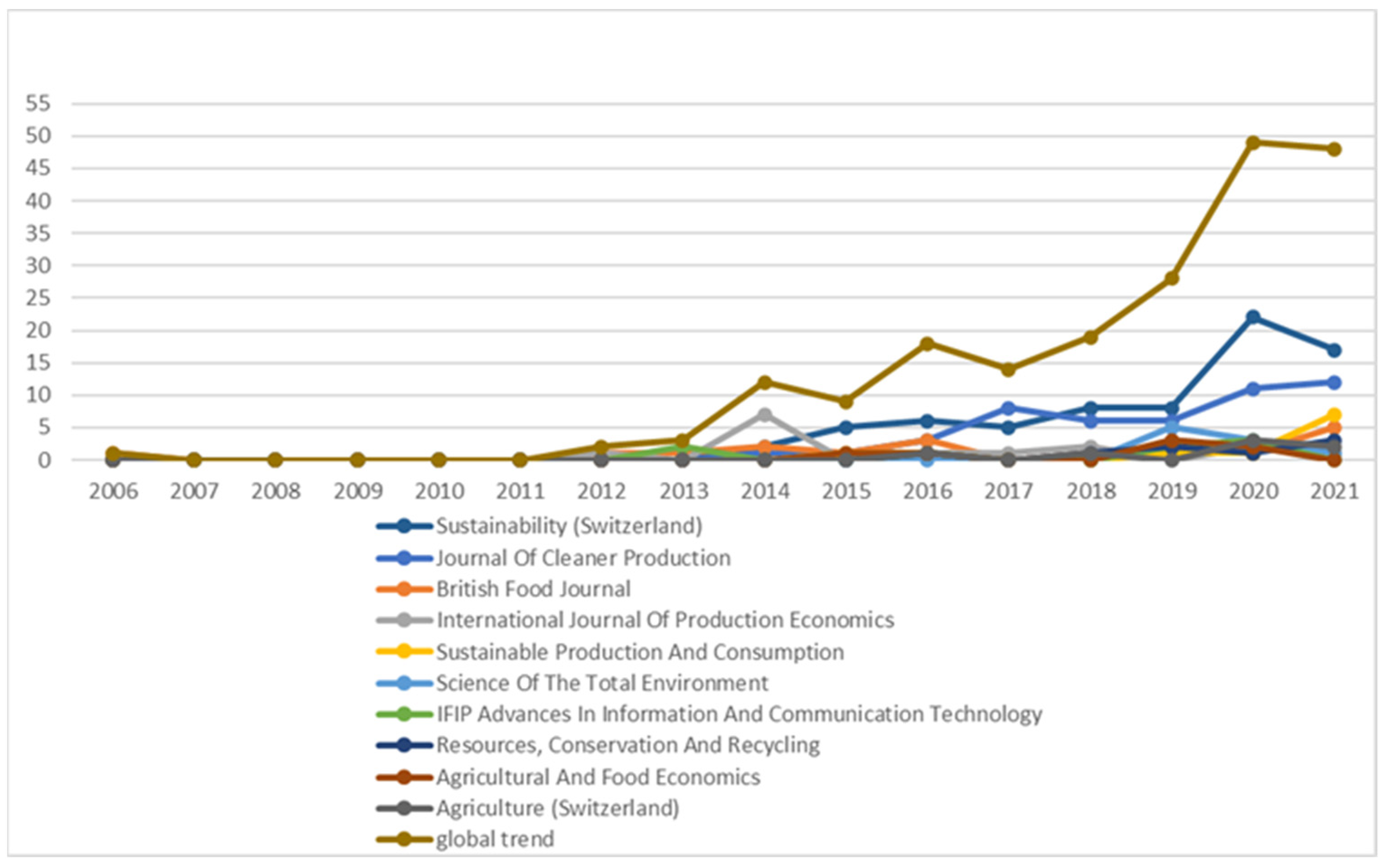
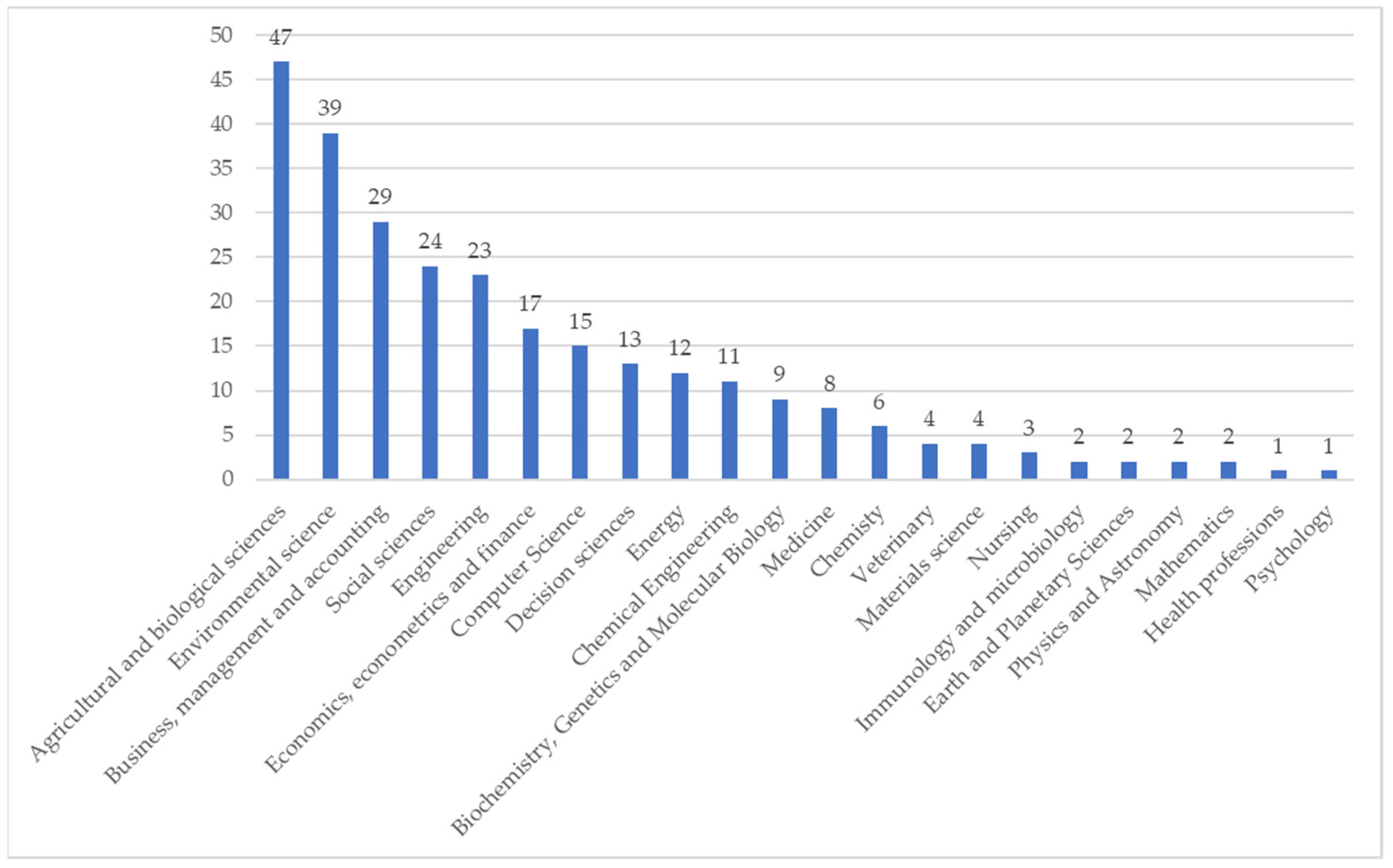
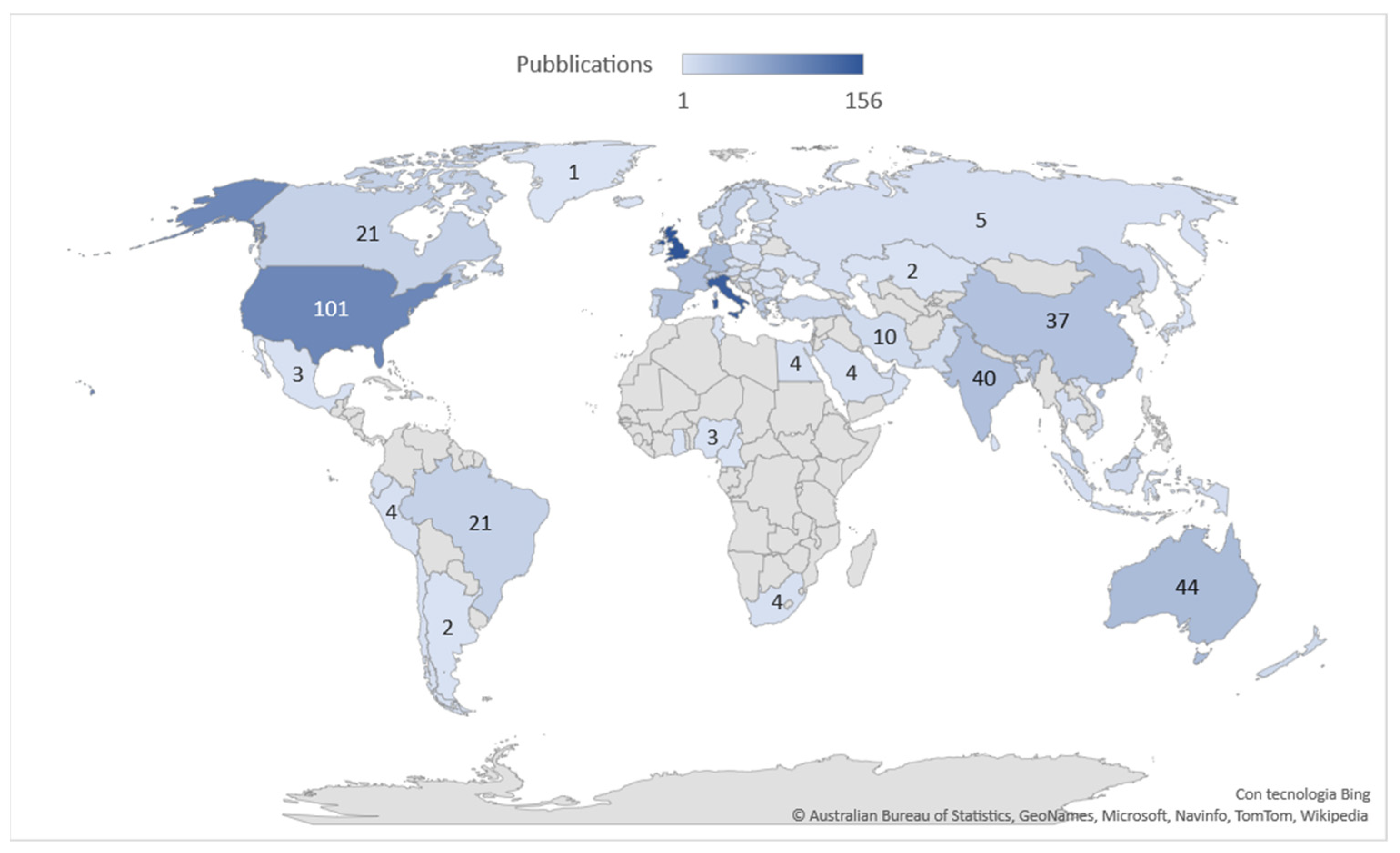
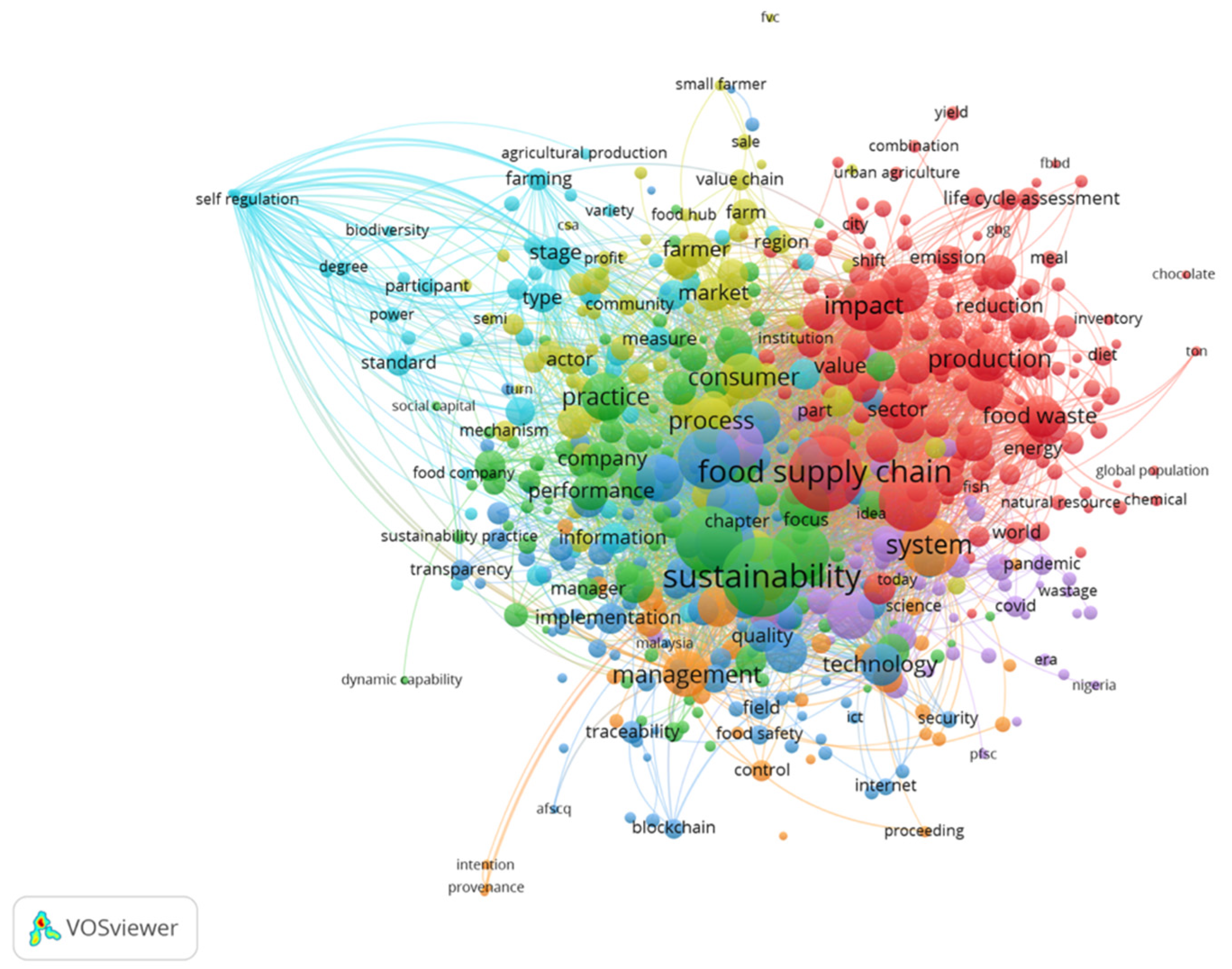

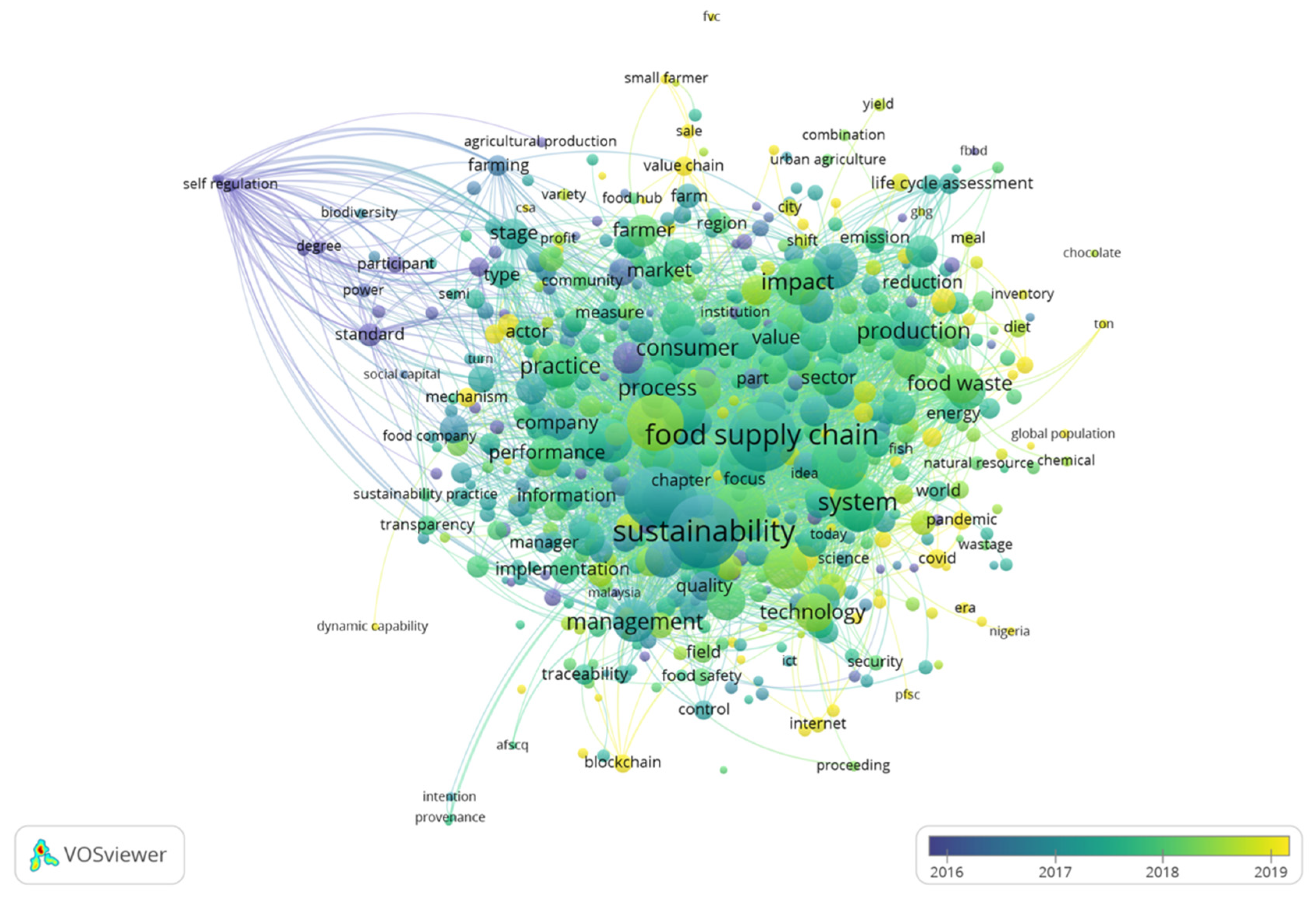
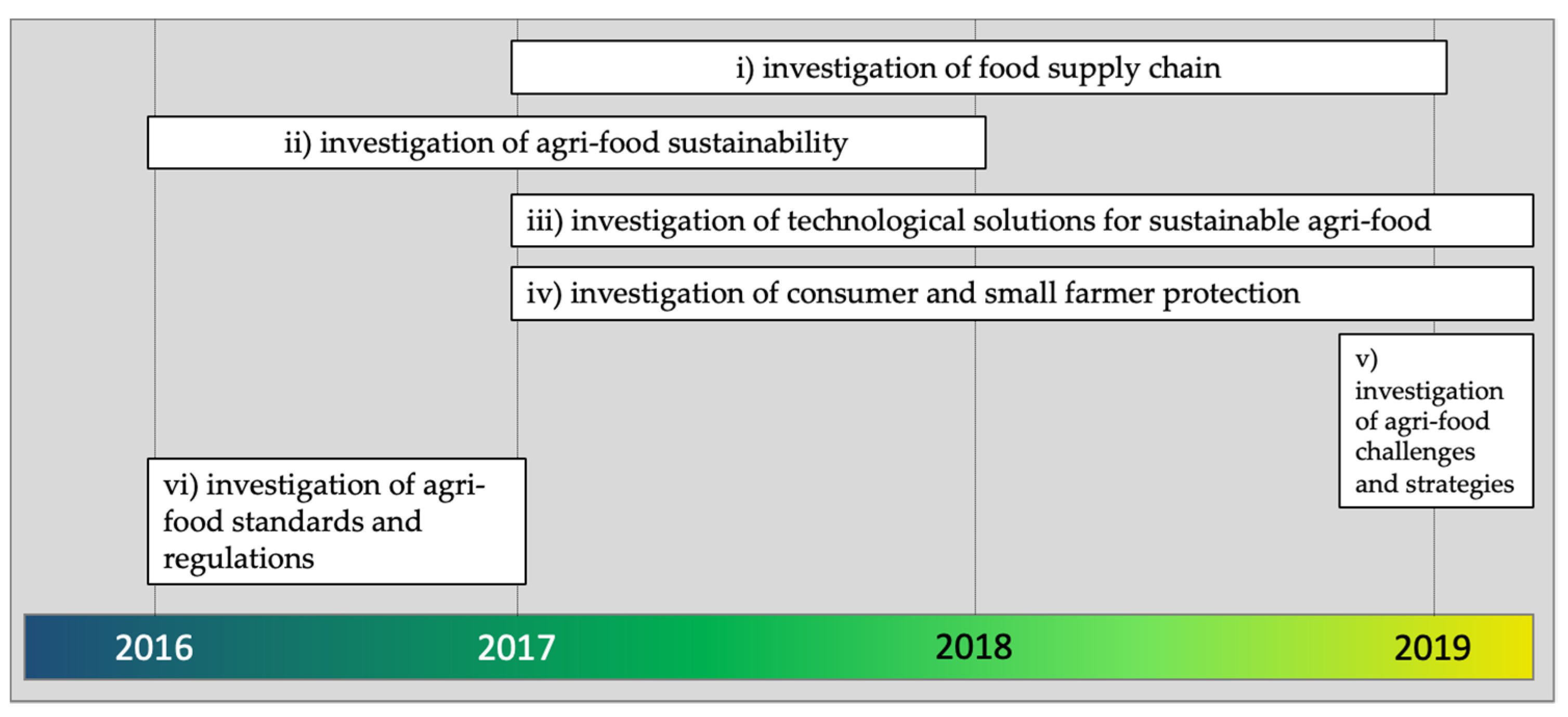
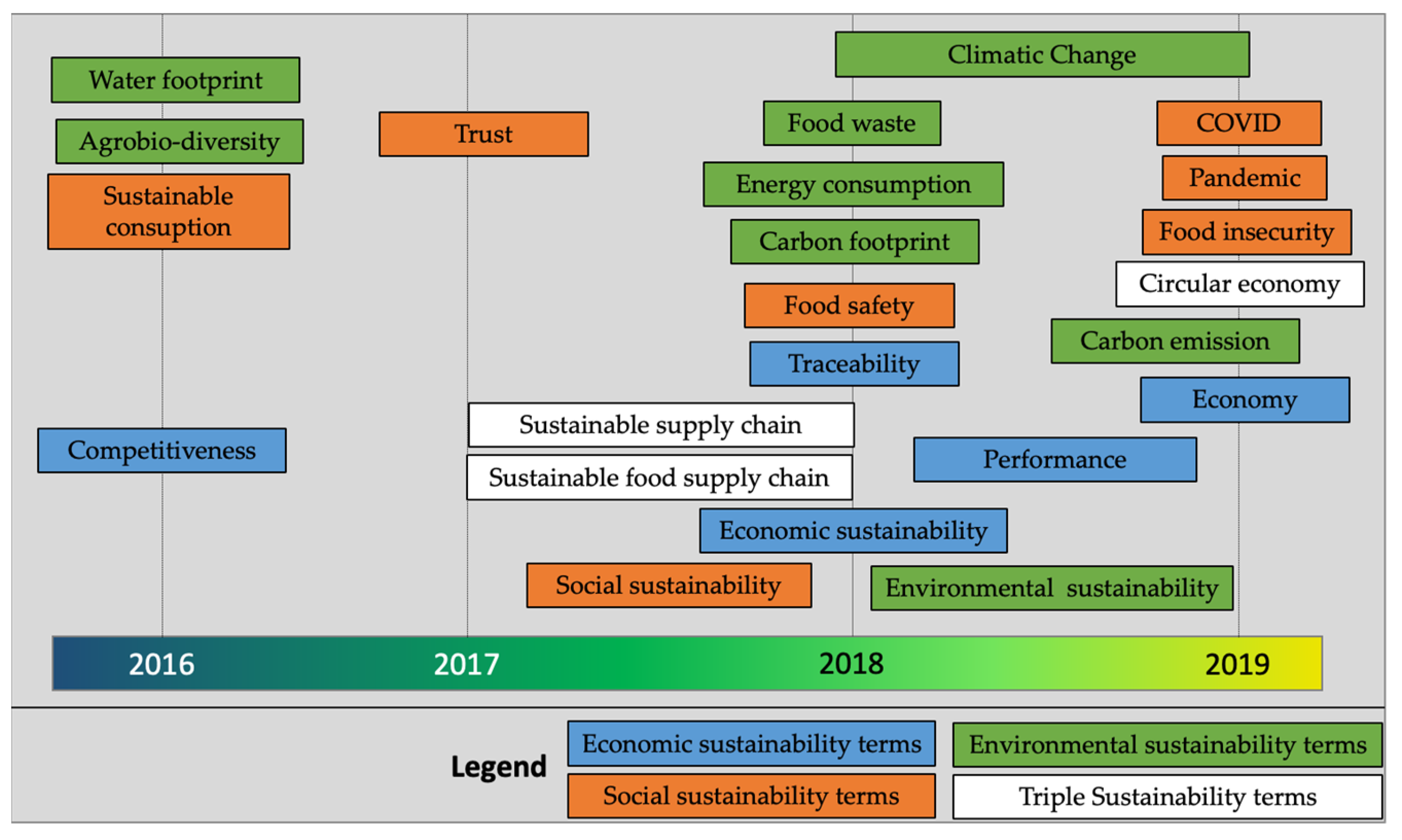
| Current Research Routes | Main Research Themes |
|---|---|
| Searching efficiency in food supply chain. |
| Global food supply chain management. | |
| Food lifecycle assessment. | |
| Environmental impact of the food supply chain. | |
| Raw materials and resource management along the food supply chain. | |
| Environmental impact of agri-food industry. |
| Social impact of agri-food industry. | |
| Corporate Social Responsibility in agri-food industry. | |
| Economic impact of agri-food industry. | |
| Sustainable business model for agri-food industry. | |
| Technological enabler to sustainable agri-food industry. |
| Food traceability systems. | |
| Blockchain technologies in agri-food industry. | |
| Information sharing and communication technologies in agri-food industry. | |
| IoT technologies in agri-food industry. | |
| Alternative food network analysis. |
| Circular economy models. | |
| Cooperation analysis among farmers, producer and consumers. | |
| Local food system models. | |
| Profitability and social benefits for agri-food communities. | |
| Agri-food competitiveness. |
| Impact of COVID19 pandemic in agri-food industry. | |
| Food insecurity and risk management. | |
| Shelf life and perishable product management. | |
| Infrastructure and digital technology management. | |
| Industry self-regulation. |
| Food standard management. | |
| Food supply chain compliance to regulations and standard. | |
| Impact of government and measure on agri-food industry. | |
| Safeguard of agrobiodiversity. |
Publisher’s Note: MDPI stays neutral with regard to jurisdictional claims in published maps and institutional affiliations. |
© 2021 by the authors. Licensee MDPI, Basel, Switzerland. This article is an open access article distributed under the terms and conditions of the Creative Commons Attribution (CC BY) license (https://creativecommons.org/licenses/by/4.0/).
Share and Cite
Latino, M.E.; Menegoli, M.; De Giovanni, M. Evaluating the Sustainability Dimensions in the Food Supply Chain: Literature Review and Research Routes. Sustainability 2021, 13, 11816. https://doi.org/10.3390/su132111816
Latino ME, Menegoli M, De Giovanni M. Evaluating the Sustainability Dimensions in the Food Supply Chain: Literature Review and Research Routes. Sustainability. 2021; 13(21):11816. https://doi.org/10.3390/su132111816
Chicago/Turabian StyleLatino, Maria Elena, Marta Menegoli, and Martina De Giovanni. 2021. "Evaluating the Sustainability Dimensions in the Food Supply Chain: Literature Review and Research Routes" Sustainability 13, no. 21: 11816. https://doi.org/10.3390/su132111816
APA StyleLatino, M. E., Menegoli, M., & De Giovanni, M. (2021). Evaluating the Sustainability Dimensions in the Food Supply Chain: Literature Review and Research Routes. Sustainability, 13(21), 11816. https://doi.org/10.3390/su132111816








